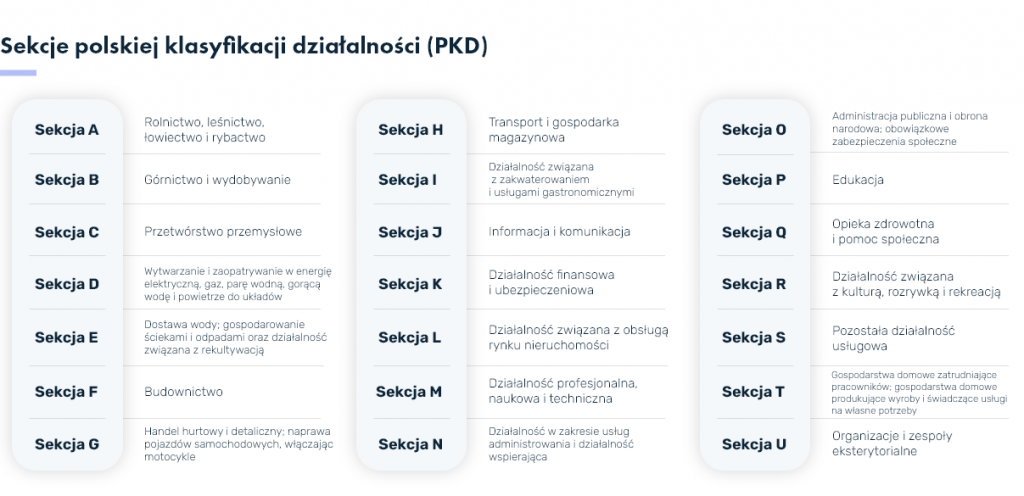What is the PAC classification?
The abbreviation PKD is the Polish Classification of Activities. This is the system in force in Polish law for dividing enterprises by the types of business activities they perform.
The PAC codes have a mainly statistical function, relevant to state activities in the sphere of planning economic movements. The PKD classification is part of the National Official Register of National Economic Entities maintained by the Central Statistical Office.
Already when preparing to submit the CEIDG-1 application (i.e., the document that enables the registration of a business), the future entrepreneur must choose the PKD code or codes that best reflect the profile of the activity he or she intends to perform.
An important piece of information for any entrepreneur is that if, in the course of business, the scope of services performed is expanded, the PKD codes assigned to the company must also be updated. There is no limit to the number of codes.
What does the list of PACs look like?
The PKD database is divided into 21 sections (denoted by letters), 88 divisions, 272 groups, 615 classes and 654 subclasses – there is plenty to choose from. This division is intended to make the code easier to find. For example, a contract lumberjack will start his search in section A – agriculture, forestry, hunting and fishing, division 02 – forestry and logging, where he will find code 02.20.Z Logging.

How to choose the company’s PKD code?
On the surface, the situation seems trivial. Ot, all we have to do is search the PKD code database and try to find in the list the most appropriate code for the type of business, as in the example below.
EXAMPLE
Ms. Catherine graduated with a degree in philology and decided to start a company providing translation services. In this situation there is no problem, just start typing the phrase “translations” in the PKD search engine and you will come across PKD code 74.30.Z, which reads “Translation activities.”
However, the situation will not always be so obvious. When facing the choice of an appropriate PKD code, we must remember that the classification we are talking about was created in 2007 and has not seen any update since then. In a dynamically changing market situation, this means that the code for some companies representing the youngest branches of the economy may simply… not exist.
The choice of PAC is also important because activities outside the scope described by the selected codes risk a fine for the company.
EXAMPLE
Ms. Catherine, after a few months of running her business, decides to expand the range of services she performs and also offer clients the creation of content in English and… create a blog with language advice. However, here is where the difficulty arises, because there is no code in the PKD database that corresponds one hundred percent to this type of activity.
It is worth noting at this point that nothing prevents you from choosing several codes, even if you enter them “just in case.” Who knows which way the business conducted will develop?
Example codes that the heroine of our examples could choose are:
- 63.12.Z Activities of Internet portals – useful if the entrepreneur intends to make money from blogging;
- 73.11.Z Activities of advertising agencies – necessary in the described situation. The PKD classification does not include the profession of copywriter, i.e. a writer of non-artistic texts. Therefore, the service of creating content for clients should be described in this way.
It’s also worth thinking about entering codes from section 85 (education), for example, for the circumstance of creating your own online language course, or 58 (publishing activities) if you were planning to publish your own book (including an e-book).
In the vast majority of cases, the PKD number can be found without problems – the database covers a huge number of activities, and the others should be matched as much as possible. Let’s also remember the always-available option to expand the scope of your business by adding one or more codes – this can also be done online .


